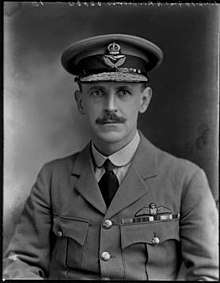Percy Groves
Brigadier-General Percy Robert Clifford Groves, CB, CMG, DSO (26 May 1878 – 12 August 1959) was a senior British air strategist who served in the British Army and the Royal Air Force (RAF).[1][2][3] He was a tireless campaigner for a radical rethink of Britain's approach to air strategy following the First World War, in particular for an immediate expansion of the RAF to parity with the largest European force within striking distance. He is perhaps best known as being an advocate of the aerial ‘’knock out blow’’: the possibility of ending a war in its early stages by launching a massive attack on the enemy’s centres of gravity.[4]
Percy Groves | |
|---|---|
 | |
| Birth name | Percy Robert Clifford Groves |
| Born | 26 May 1878 Rai Bareli, India |
| Died | 12 August 1959 (aged 81) Mombasa, Kenya |
| Allegiance | |
| Service/ | |
| Years of service | 1899–1922 1939–46 |
| Rank | Brigadier-General |
| Battles/wars | Second Boer War First World War |
| Awards | Companion of the Order of the Bath Companion of the Order of St Michael and St George Distinguished Service Order Order of the White Eagle, 3rd Class with Swords (Serbia) Commander of the Legion of Honour (France) |
Early life
Percy Robert Clifford Groves was born on 26 May 1878 at Rai Bareli, India.[5] He was the eldest son of Joseph Groves who served as Commissioner of Railways for the United Provinces in India.[6][7] He was educated at Bedford Modern School.[8]
Career
Groves joined the King's Shropshire Light Infantry in 1899 and served in the Second Boer War.[6][7] He was employed with the West African Regiment (1903–04) and was Territorial Adjutant (1909–12).[7] In 1914 he joined the Royal Flying Corps, serving with Air Services France (1914–15).[7] On 29 April 1915, he received his Royal Aero Club Aviator’s Certificate passing on a Maurice Farman Biplane at Farman Aerodrome, Étampes.[5] He did much active flying in the Dardanelles (1915–16).[1][7]
Between 1916 and 1918, he was Chief of Staff, Royal Flying Corps, in the Middle East "which then embraced four theatres of war".[1][7] In 1918 he was made Director of Flying Operations at the Air Ministry.[1][7] He was then Britain's Air Ministry Representative at the Paris Peace Conference (1919)[2] and British air adviser to the Supreme Council and the Conference of Ambassadors (1921–22).[2]
Groves retired from active service in 1922 with the rank of brigadier general.[7] Based on his experiences on active service, Groves realised that Britain needed to radically rethink its approach to air strategy.[1] Shortly after his retirement from the forces, he proceeded to campaign "for the creation of an effective striking force and for a proper regard for the patent realities of civil aviation".[1] His opinions attracted the interest of Viscount Northcliffe and in 1922 a series of articles on "Our Future in the Air" were published in The Times.[1] He remained a forceful campaigner for an immediate expansion of the RAF to parity with the largest European force within striking distance.[1]
In 1939 Groves returned to active service being made Deputy Director of Intelligence at the Air Ministry, a position he held until April 1940.[1] He was then seconded to the Foreign Office before being demobilised in 1946.[1]
Military strategist
Groves was a colleague of Frederick Sykes and Viscount Trenchard, who both influenced his early military thinking.[4] He was also engaged in lengthy correspondence with Sir Basil Liddell Hart.[9] In terms of his military thinking, Groves is perhaps best known as being an advocate of the aerial ‘’knock out blow’’: the possibility of ending a war in its early stages by launching a massive attack on the enemy's centres of gravity.[4]
Awards and honours
In the Second Boer War he was awarded the Queen's medal (4 clasps) and the King's medal (2 clasps).[7]
During the First World War he was awarded the Distinguished Service Order in 1916.[7] In the same year he was made Order of the White Eagle of Serbia, 3rd Class with Swords.[7] He was made a Companion of the Order of St Michael and St George in 1918, a Companion of the Order of the Bath in 1919 and a Commander of the Legion of Honour in 1920.[7]
Groves was an Associate Fellow of the Royal Aeronautical Society; Hon. Secretary General Air League of British Empire, and Editor of Air, 1927–29. He was group captain and honorary air commodore, RAFVR, September 1939.[7]
Personal life
Groves was a member of the United Service Club.[7] In 1920 he married Suzanne, daughter of T.E. Steen of Oslo; they had one son.[7] He died in Mombasa on 12 August 1959.[6][7]
The National Portrait Gallery has numerous photographic portraits of Groves.[10]
Selected works
- Flying over Egypt, Sinai and Palestine, National Geographic, 1926[11]
- Behind the Smoke Screen, 1934[12]
- Our Future In The Air, 1935[13]
References
- Obituary, Brigadier-General P. R. C. Groves – Campaigner For Air Power, The Times, 17 August 1959
- Kelly’s Handbook to the Titled, Landed and Official Classes 1958, Published by Kelly’s Directories Limited 1958
- "Brig.-Gen. Percy Robert Clifford GROVES". militarian.com. Retrieved 29 January 2015.
- Coetzee, Daniel; Eysturlid, Lee W. (21 October 2013). Philosophers of War. ISBN 9780313070334. Retrieved 7 July 2015.
- "Genealogy, Family Trees & Family History Records at Ancestry.co.uk". ancestry.co.uk. Retrieved 6 July 2015.
- Obituary, Brigadier-General P. R. C. Groves, The Times, 17 August 1959
- "Who's Who". ukwhoswho.com. Retrieved 6 July 2015.
- The Harpur Trust 1552–1973, by Joyce Godber, 1973
- "Groves, Percy Robert Clifford (1878–1959) Brigadier General". nationalarchives.gov.uk. Retrieved 7 July 2015.
- "National Portrait Gallery – Person – Percy Robert Clifford Groves". npg.org.uk. Retrieved 29 January 2015.
- Steet, Linda (2000). Veils and Daggers. ISBN 9781566397520. Retrieved 7 July 2015.
- Behind the smoke screen. worldcat.org. OCLC 1326185.
- Formats and Editions of Our future in the air, [WorldCat.org]. worldcat.org. OCLC 2218791.